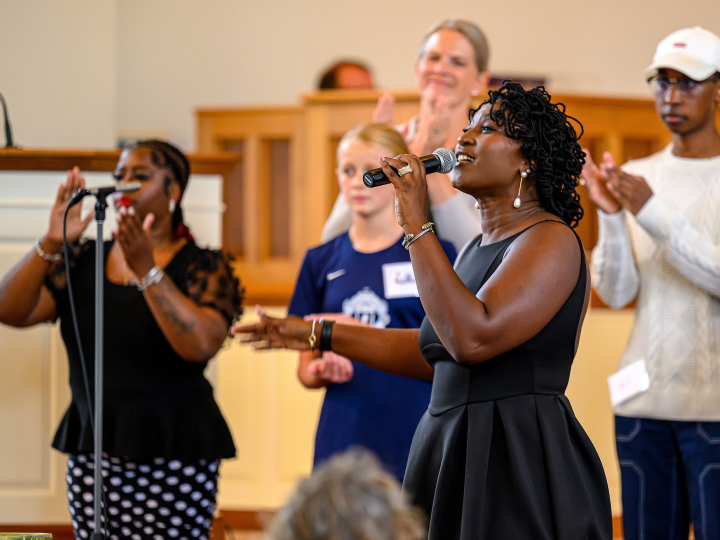Words to Last a Lifetime
January 18, 2016
At 11 a.m. on a warm, damp Wednesday morning in April 1958, Carolyn Schaaf Horter '61 stepped into the Davis Gym Annex for a weekly chapel service — one of 40 she would need to attend in order to graduate from Bucknell. She walked out with words that would stick with her for the next five decades.
The speaker that morning: the Rev. Martin Luther King Jr.
"King preached about the breadth, length, height and depth of life," Horter recalled recently. "He was a powerful speaker. I was impressed and for some reason those words from his speech have stuck in my mind. It was a challenge then to any student, to 'stretch' ourselves like that and it is an even more challenging text today."
3-D in religion
Horter saw King speak during a Bucknell chapel service on April 23, 1958, King's only visit to the University. The speech he gave on that occasion, "Three Dimensions of a Complete Life," was among the orator's oldest, favorite sermons. Also called "3-D in Religion" by King, the sermon began with the speaker recounting John of Patmos' vision in Revelation of "a new city of God... complete in all three of its dimensions."
"Dr. King's talk... followed the theme that life must be three-dimensional in order to be complete," Jan Powers '61 recounted in the May 1, 1958, edition of The Bucknellian. "The first dimension is the length of life or concern for rational and moral self-interest. According to Dr. King, 'When we do life's work so well that no one else could do it better, we have filled the length of life.'
"The second dimension, the extension of life to others, involves the capacity for 'dangerous costly altruism' similar to that exhibited by the Good Samaritan. Dr. King pointed out that every object in our daily life is dependent upon other persons and other parts of the world.
"It is not enough that our lives have length and breadth. We must reach up and discover God, the third dimension of height."
According to theology scholar Richard Lischer, King had preached the sermon as early as his days as a doctoral student at Boston University (where he graduated in June 1955). It was also his "trial sermon" when he was being considered for pastorship of Dexter Avenue Baptist Church in Montgomery, Ala.
The sermon was an appropriate choice for delivery at a liberal arts university as, according to Lischer, it "articulated broad themes of liberalism with which its educated audience would have been familiar."
" '3-D in Religion' represented the balanced considerations of a sensible young scholar," Lischer wrote in The Preacher King: Martin Luther King, Jr. and the Word that Moved America.
A memorable luncheon
King spoke in the Davis Gym Annex, an area at the rear of the gymnasium now occupied by offices, where chapel services were held at the time (the University had outgrown the churches in downtown Lewisburg and Rooke Chapel would not be constructed until 1964). Chapel service attendance was compulsory at the time, with students needing to attend 40 services before graduating.
After chapel, King ate lunch with about 20 faculty members and administrators in an upstairs room at Cooley Hall, which served as a de facto faculty dining room. Retired chemistry professor Ben Willeford, a lifelong civil rights advocate, was among them.
"There was sort of a reception line, but not a formal sort of thing and everybody got to meet Dr. King," Willeford said. "We ate lunch and afterward there was an informal question and answer session. Anybody in the group could ask a question and he would respond and some discussion followed."
Bringing King to campus
The key to bringing King to campus was Mark Ebersole, a professor of religion who was chaplain of the University in 1958. (Ebersole went on to become provost of Bucknell and president of Elizabethtown College.) Ebersole and King both studied at Crozer Theological Seminary near Philadelphia, though not at the same time and were coleaders of a Week of Prayer event at Virginia Union University in Richmond, Va., Feb. 24–March 1, 1957. Their meeting in Virginia led directly to King's visit to Bucknell.
Ebersole wrote to King on April 4, 1957, recapping their meeting at Virginia Union and asking whether King would be interested in being a chapel speaker at Bucknell during the 1957–58 academic year. King agreed and in subsequent letters to Ebersole and Bucknell set the date and made other arrangements for his visit. (The complete correspondence between King and Ebersole/Bucknell is housed at the Howard Gotlieb Archival Research Center at Boston University.)
At the time of his speech, King was already a national public figure. His leadership in the 1955–56 bus boycott in Montgomery, Ala., had thrust him into the national spotlight and on June 23, 1958, two months after his speech at Bucknell, he was among a group of four civil rights leaders who met with President Eisenhower. But he was not, as Carmen Gillespie, professor of English and director of the Griot Institute for Africana Studies, said, the "universally accepted icon of civil rights activism" he is seen as today.
"He certainly would have been a figure that people would have been aware of," Gillespie said, "but a much more controversial figure in terms of understanding him as part of a fundamental acknowledged leadership of the United States, which I would argue is the situation now, with his statue on the Mall. When he came in 1958 it would have been in a very different context."
Willeford, though, said King's visit to Bucknell was not marred by controversy. He was not the first African-American to speak at a Bucknell chapel service — the Rev. Charles Boddie, a pastor from Rochester, N.Y., was a chapel regular at that time, Willeford recalled and there were others. While the 1955–56 bus boycott had incited violent backlash, including the firebombing of King's home, "That was down there," Willeford said.
"He wasn't organizing a boycott in Lewisburg and as far as I know no one had accused him of being a communist quite yet — that came in later on," he added.
King's visit to campus did engender excitement, however and some were disappointed that his speech did not directly address the civil rights movement.
"I think a lot of people were expecting a civil rights speech and he gave a sermon," Willeford recalled. "He said, 'This is a chapel service; I'm going to give a sermon.' "
Ongoing legacy
The speech had no less a powerful impact to those that heard it, however.
"I vividly remember hearing him speak," said Powers, who after her Bucknellian days went on to become a professor at Gettysburg College, where she taught courses in black literature and culture. "Living through the civil rights movement and hearing speakers like Dr. King was a life-changing experience."
The visit is an important event in Bucknell's history, said Gillespie, adding that plans are underway to memorialize King's visit and the 140th anniversary of the graduation of Edward Brawley, Bucknell's first African-American graduate, with a sculpture that will be placed on a prominent place on campus. Professor Joe Meiser, art & art history will be the designer and sculptor of the commemorative bust, which will feature a likeness of Brawley and King's words.
"Remembering and recognizing the contributions of people like Dr. King who spent their lives trying to transform humanity is one of the most valuable things we can do to move forward into a future where hatred, violence, discrimination and exclusion are not the norm," said Gillespie. "It's not about remembering someone as a static relic of the past, but seeing his or her message as dynamic and as something that needs to be sustained."
"It's a reminder that Bucknell was open to discussion of things like that," added Willeford. "Although you could say that this was a preaching engagement rather than a civil rights engagement, nevertheless it was a forward step for Bucknell — not to be frightened off by controversial people. May it ever be thus."
Read more about how Bucknell is celebrating King's legacy during MLK Week below.

